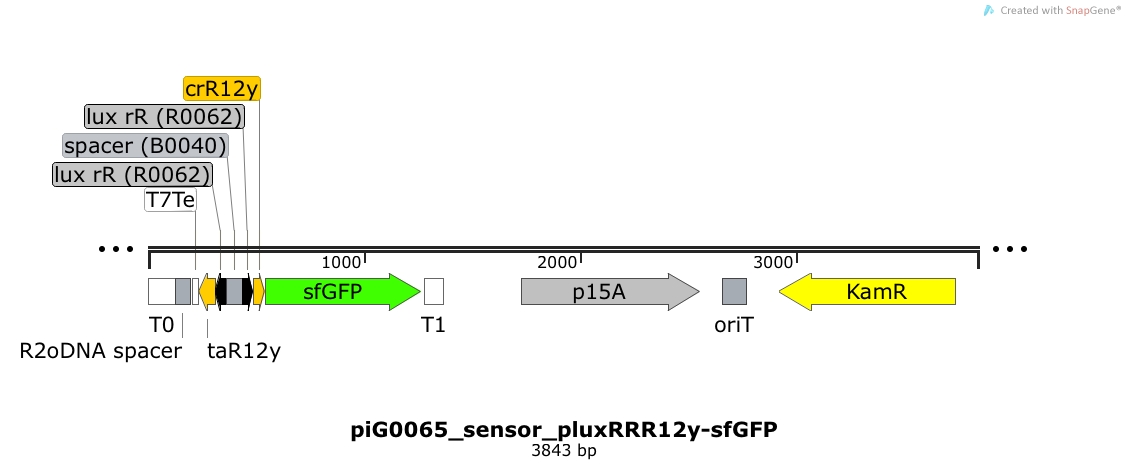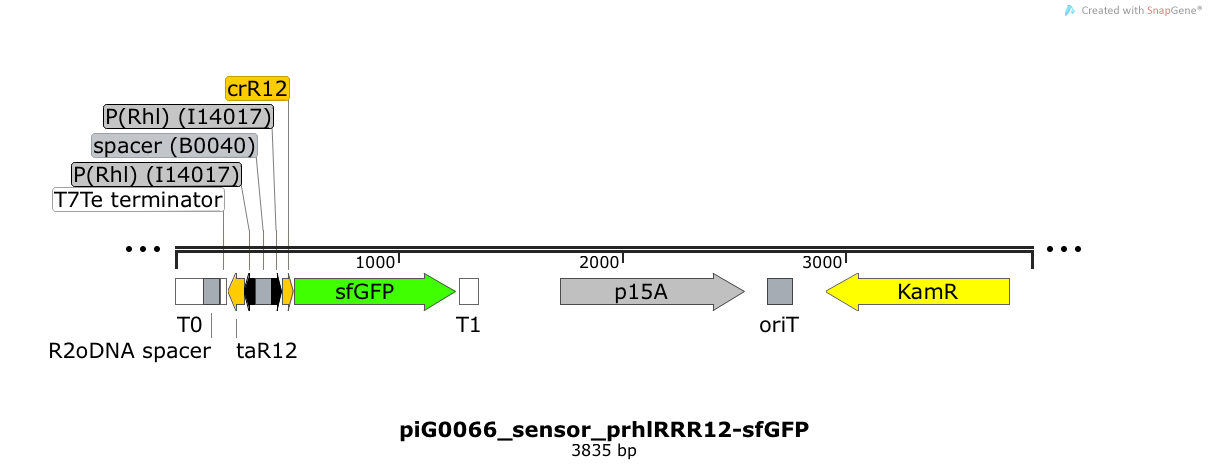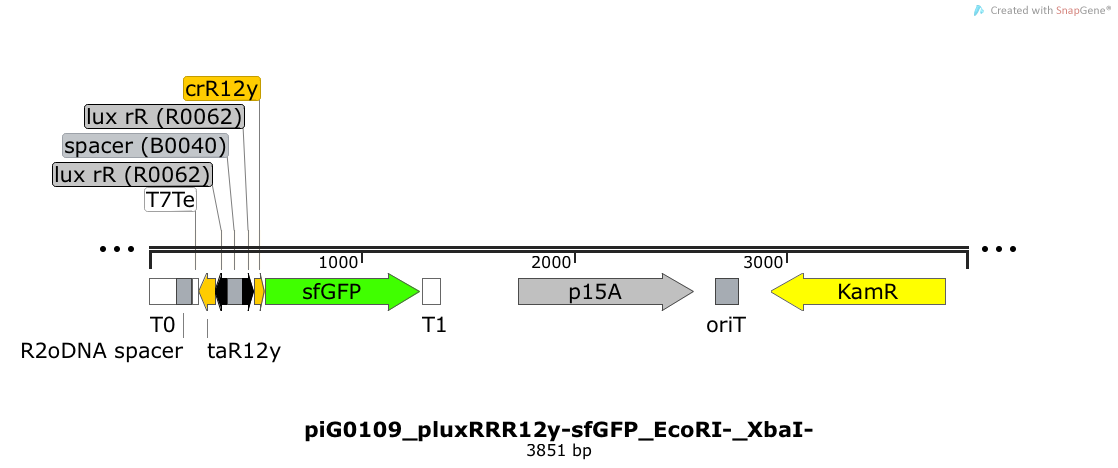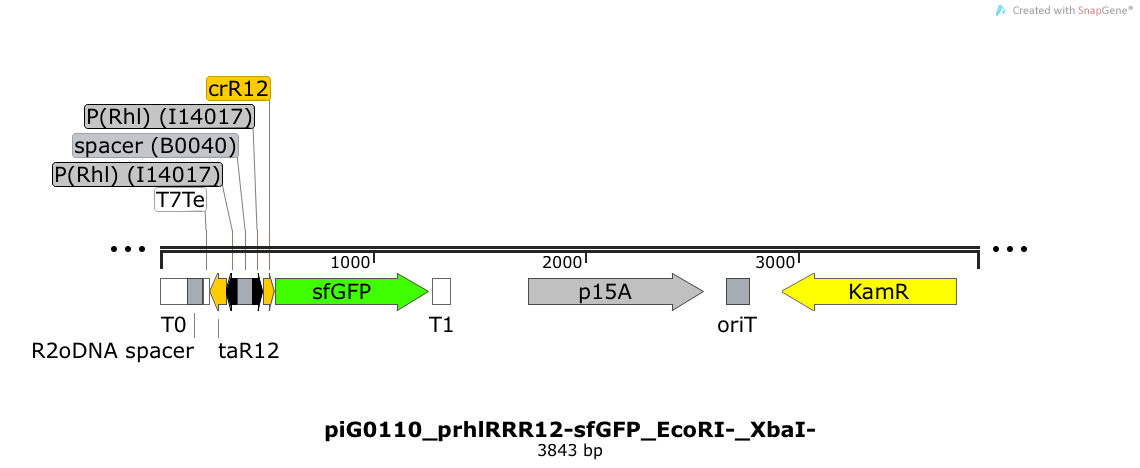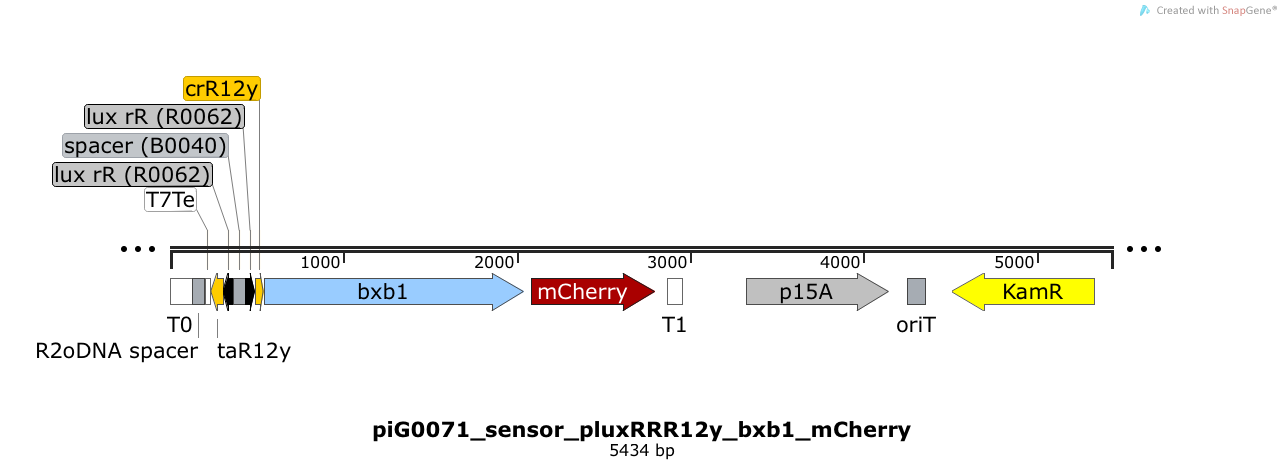Team:ETH Zurich/lab/sequences
From 2014.igem.org
| Line 5: | Line 5: | ||
[[Team:ETH_Zurich/lab/sequences#Regulator_Constructs|Regulator Constructs]] | [[Team:ETH_Zurich/lab/sequences#Regulator_Constructs|Regulator Constructs]] | ||
| + | |||
[[Team:ETH_Zurich/lab/sequences#Producer_Constructs|Producer Constructs]] | [[Team:ETH_Zurich/lab/sequences#Producer_Constructs|Producer Constructs]] | ||
| + | |||
[[Team:ETH_Zurich/lab/sequences#Sensor Constructs|Sensor Constructs]] | [[Team:ETH_Zurich/lab/sequences#Sensor Constructs|Sensor Constructs]] | ||
| + | |||
[[Team:ETH_Zurich/lab/sequences#BUFFER_Gate_Construct|BUFFER Gate Construct]] | [[Team:ETH_Zurich/lab/sequences#BUFFER_Gate_Construct|BUFFER Gate Construct]] | ||
| + | |||
[[Team:ETH_Zurich/lab/sequences#Signal_Propagation_Construct|Signal Propagation Construct]] | [[Team:ETH_Zurich/lab/sequences#Signal_Propagation_Construct|Signal Propagation Construct]] | ||
| + | |||
[[Team:ETH_Zurich/lab/sequences#Combined_Sensor_and_Producer_Constructs|Combined Sensor and Producer Constructs]] | [[Team:ETH_Zurich/lab/sequences#Combined_Sensor_and_Producer_Constructs|Combined Sensor and Producer Constructs]] | ||
Revision as of 20:49, 17 October 2014
Sequences
The plasmid sequences can be accessed by clicking on the plasmid name (e.g. piG0040) or the plasmid picture.
Combined Sensor and Producer Constructs
Regulator Constructs
LasR is expressed under the strong constitutive promoter [http://parts.igem.org/Part:BBa_J23100 BBa_J23100] controlled by the RBS [http://parts.igem.org/Part:BBa_B0034 BBa_B0034]. LasR bound to 3OC12-HSL induces the expression of genes under the control of pLasR. The plasmid pBR322 and its derivatives have a copy number of 15 to 20[15].
LuxR is expressed under the strong constitutive promoter [http://parts.igem.org/Part:BBa_J23100 BBa_J23100] controlled by the RBS [http://parts.igem.org/Part:BBa_B0034 BBa_B0034]. LuxR bound to 3OC6-HSL induces the expression of genes under the control of pLuxR. The plasmid pBR322 and its derivatives have a copy number of 15 to 20[15].
RhlR is expressed under the strong constitutive promoter [http://parts.igem.org/Part:BBa_J23100 BBa_J23100] controlled by the RBS [http://parts.igem.org/Part:BBa_B0034 BBa_B0034]. RhlR bound to C4-HSL induces the expression of genes under the control of pRhlR. The plasmid pBR322 and its derivatives have a copy number of 15 to 20[15].
RhlR is expressed under the strong constitutive promoter [http://parts.igem.org/Part:BBa_J23100 BBa_J23100] controlled by an RBS optimised for RhlR (RBS calculator). RhlR bound to C4-HSL induces the expression of genes under the control of pRhlR. The plasmid pBR322 and its derivatives have a copy number of 15 to 20[15].
LuxR is expressed under the weak constitutive promoter [http://parts.igem.org/Part:BBa_J23109 BBa_J23109] controlled by the RBS [http://parts.igem.org/Part:BBa_B0034 BBa_B0034]. LuxR bound to 3OC6-HSL induces the expression of genes under the control of pLuxR. The plasmid pBR322 and its derivatives have a copy number of 15 to 20[15].
LuxR is expressed under the medium strong constitutive promoter [http://parts.igem.org/Part:BBa_J23111 BBa_J23111 ] controlled by the RBS [http://parts.igem.org/Part:BBa_B0034 BBa_B0034]. LuxR bound to 3OC6-HSL induces the expression of genes under the control of pLuxR. The plasmid pBR322 and its derivatives have a copy number of 15 to 20[15].
Producer Constructs
LasI is expressed under the strong constitutive promoter [http://parts.igem.org/Part:BBa_J23100 BBa_J23100 ] controlled by the RBS [http://parts.igem.org/Part:BBa_B0034 BBa_B0034]. LasI produces the quorum sensing molecule 3OC12-HSL. The pBBR1 origin is present at a copy number of approximately 5, however, the origin is poorly characterized [16].
LasI is expressed under the strong constitutive promoter [http://parts.igem.org/Part:BBa_J23100 BBa_J23100 ] controlled by an RBS optimised for LasI (RBS calculator). LasI produces the quorum sensing molecule 3OC12-HSL. The pBBR1 origin is present at a copy number of approximately 5, however, the origin is poorly characterized [16].
LuxI is expressed under the strong constitutive promoter [http://parts.igem.org/Part:BBa_J23100 BBa_J23100 ] controlled by the RBS [http://parts.igem.org/Part:BBa_B0034 BBa_B0034]. LuxI produces the quorum sensing molecule 3OC6-HSL. The pBBR1 origin is present at a copy number of approximately 5, however, the origin is poorly characterized[16].
LuxI is expressed under the strong constitutive promoter [http://parts.igem.org/Part:BBa_J23100 BBa_J23100 ] controlled by an RBS optimised for LuxI (RBS calculator). LuxI produces the quorum sensing molecule 3OC6-HSL. The pBBR1 origin is present at a copy number of approximately 5, however, the origin is poorly characterized[16].
RhlI is expressed under the strong constitutive promoter [http://parts.igem.org/Part:BBa_J23100 BBa_J23100 ] controlled by the RBS [http://parts.igem.org/Part:BBa_B0034 BBa_B0034]. RhlI produces the quorum sensing molecule C4-HSL. The pBBR1 origin is present at a copy number of approximately 5, however, the origin is poorly characterized[16].
RhlI is expressed under the strong constitutive promoter [http://parts.igem.org/Part:BBa_J23100 BBa_J23100 ] controlled by an RBS optimised for RhlI (RBS calculator). RhlI produces the quorum sensing molecule C4-HSL. The pBBR1 origin is present at a copy number of approximately 5, however, the origin is poorly characterized[16].
Sensor Constructs
Expression of sfGFP is induced when LasR bound to 3OC12-HSL bind to pLasR. The p15A is present at a copy number of approximately 15 to 25[35].
Expression of sfGFP is induced when LuxR bound to 3OC6-HSL bind to pLuxR. The p15A is present at a copy number of approximately 15 to 25[35].
Expression of sfGFP is induced when RhlR bound to 4C-HSL bind to pRhlR. The p15A is present at a copy number of approximately 15 to 25[35].
Expression of sfGFP is induced when LuxR bound to 3OC6-HSL bind to pLuxR. The cis-repressive element (crR12y) inhibits the translation of sfGFP, since the RBS is blocked by secondary structures of the mRNA. The p15A is present at a copy number of approximately 15 to 25[35].
Expression of sfGFP is induced when LuxR bound to 3OC6-HSL bind to pLuxR. The cis-repressive element (crR12y) inhibits the translation of sfGFP, since the RBS is blocked by secondary structures of the mRNA. The transcript of the trans-activating element (taR12y) binds to the transcript of the cis-repressive element, hence the RBS is not blocked anymore. The two elements build a riboregulator that decreases leakiness of pLuxR. The p15A is present at a copy number of approximately 15 to 25[35].
Expression of sfGFP is induced when RhlR bound to 4C-HSL bind to pRhlR. The cis-repressive element (crR12) inhibits the translation of sfGFP, since the RBS is blocked by secondary structures of the mRNA. The transcript of the trans-activating element (taR12) binds to the transcript of the cis-repressive element, hence the RBS is not blocked anymore. The two elements build a riboregulator that decreases leakiness of pLuxR. The p15A is present at a copy number of approximately 15 to 25[35].
Expression of sfGFP is induced when LuxR bound to 3OC6-HSL bind to pLuxR. The cis-repressive element (crR12y) inhibits the translation of sfGFP, since the RBS is blocked by secondary structures of the mRNA. The transcript of the trans-activating element (taR12y) binds to the transcript of the cis-repressive element, hence the RBS is not blocked anymore. The two elements build a riboregulator that decreases leakiness of pLuxR. The p15A is present at a copy number of approximately 15 to 25[35]. PiG0109 is a derivate of piG0065 where the restriction sites EcoRI and XbaI have been removed. Thus, the two constructs slightly differ in the sequence of the 3'-end of the trans-activating element and in the sequence of the 5'-end of the cis-repressive element.
Expression of sfGFP is induced when RhlR bound to 4C-HSL bind to pRhlR. The cis-repressive element (crR12) inhibits the translation of sfGFP, since the RBS is blocked by secondary structures of the mRNA. The transcript of the trans-activating element (taR12) binds to the transcript of the cis-repressive element, hence the RBS is not blocked anymore. The two elements build a riboregulator that decreases leakiness of pLuxR. The p15A is present at a copy number of approximately 15 to 25[35]. PiG0110 is a derivate of piG0066 where the restriction sites EcoRI and XbaI have been removed. Thus, the two constructs slightly differ in the sequence of the 3'-end of the trans-activating element and in the sequence of the 5'-end of the cis-repressive element.
BUFFER Gate Construct
The directional terminator [http://parts.igem.org/Part:BBa_B0015 BBa_B0015] blocks transcription of sfGFP under the strong constitutive promoter [http://parts.igem.org/Part:BBa_J23100 BBa_J23100]. Only if the integrase Bxb1 flips B0015 between the attP and the attB sites, transcription of sfGFP is possible. The pBBR1 origin is present at a copy number of approximately 5, however, the origin is poorly characterized[16]
Signal Propagation Construct
Expression of the integrase Bxb1 and the fluorophore mCherry is induced when LuxR bound to 3OC6-HSL bind to pLuxR. The cis-repressive element (crR12y) inhibits the translation of Bxb1 and mCherry, since the RBS is blocked by secondary structures of the mRNA. The transcript of the trans-activating element (taR12y) binds to the transcript of the cis-repressive element, hence the RBS is not blocked anymore. The two elements build a riboregulator that decreases leakiness of pLuxR. The p15A is present at a copy number of approximately 15 to 25[35].
Combined Sensor and Producer Constructs
Expression of sfGFP and LuxI is induced when LuxR bound to 3OC6-HSL bind to pLuxR. The cis-repressive element (crR12y) inhibits the translation of the succeeding gene, since the RBS is blocked by secondary structures of the mRNA. The transcript of the trans-activating element (taR12y) binds to the transcript of the cis-repressive element, hence the RBS is not blocked anymore. The two elements build a riboregulator that decreases leakiness of pLuxR. The p15A is present at a copy number of approximately 15 to 25[35].
 "
"


















